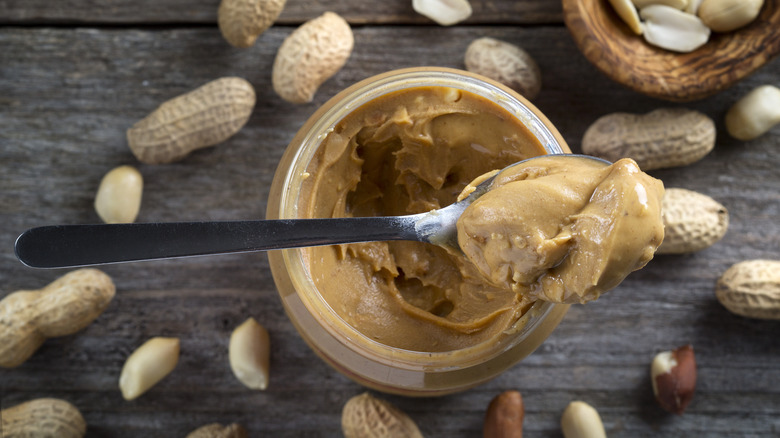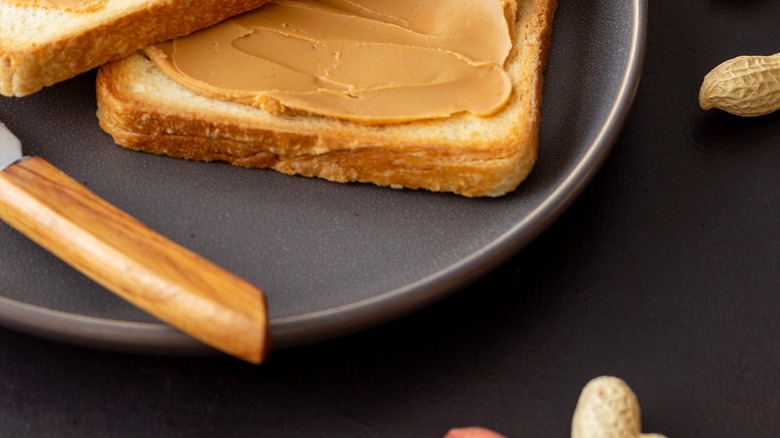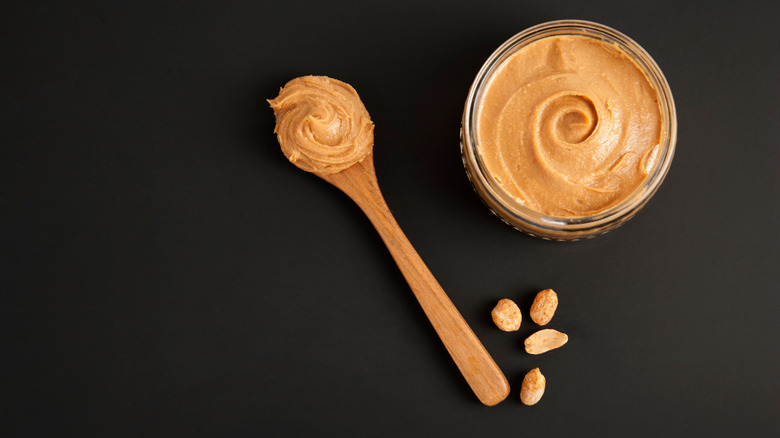Store Natural Peanut Butter Upside Down For The Smoothest Results
For the longest time, the only conundrum when it came to buying peanut butter was whether to go for the creamy or the crunchy product. These days, there's a more pressing question: should you go for natural peanut butter or the more conventional ones? Natural peanut butter is generally considered superior to conventional options mainly because of its ingredient list. Where natural peanut butter contains little besides peanuts and salt in it, the conventional spread has things like added sugar and hydrogenated vegetable oil within them.
While this gives natural peanut butter an edge over conventional ones, it also means that they don't have anything that will help keep it smooth and creamy. This is why a natural peanut butter can often turn dry, gritty, and clumpy. Thankfully, there's an easy solution. The trick to keeping natural peanut butter smooth is to store the jar properly. Rather than keeping the jar of peanut butter as it is, you should store it upside down instead, as this helps the natural oils present in the peanut butter to move through the jar, consequently keeping it smooth at all times. Even if you like your natural nut butter crunchy rather than creamy, oil separation can make a natural peanut butter incredibly hard to work with, so keeping it upside down is the safest bet to ensuring its spreadable consistency.
Why natural peanut butter becomes dry and clumpy
There's a reason why conventional peanut butter has sugar and hydrogenated vegetable oil in them, and it's not just to add flavor to the nut spread. Peanut butter is made by grinding peanuts until their natural oils are released, turning the nuts into a smooth and buttery paste. Unfortunately, as the nut butter sits out, these natural oils present inside turn back into a liquid and separate from the rest of the spread.
The sugars and hydrogenated vegetable oils added to conventional peanut butter act as stabilizers that prevent the oil from separating, helping it stay at a smooth and spreadable consistency for a long time, despite the temperature fluctuation it may go through. Without these stabilizers, natural peanut butter has virtually nothing to prevent the oil separation and preserve its smooth texture, so it will often have a pool of liquid oil sitting at the top of the jar and dried-out butter at the bottom. This is also why the Food and Drug Administration allows a spread to be labeled as peanut butter as long as 90 percent is made of peanuts, leaving 10 percent open for seasonings and stabilizers.
Fret not, however, for oil separation doesn't have to stop you from choosing a natural peanut butter over a stabilizer-filled conventional one. As long as you follow this trick for storing peanut butter, your nut spread will always be at a spreadable consistency.
How to keep peanut butter smooth at all times
The key to smooth peanut butter is surprisingly simple; you only need to keep the jar upside down. There's little that you can do to prevent the oil separation in a natural peanut butter, so the next best thing to do is to make sure that the oil doesn't just sit at the top all the time.
By keeping it upside down, you're allowing the oil to travel slowly all the way up to the bottom of the jar. When you flip the jar back up to use the peanut butter, the oil will once again move to the top. The constant slow motion will keep the oil moving all throughout the jar of peanut butter, which will prevent any dry and clumpy spots, helping it stay smooth without you having to vigorously whisk the oil back into the rest of the dry spread. This storage trick can also work for other nut butter and seed-based pastes like tahini.
Another way to fix oil separation and keep peanut butter smooth is to stir some neutral oil into the jar. Adding a few drops of water to the butter and heating it can also bring back the smooth texture but hey, why go through all that trouble when you can simply store a jar of peanut butter upside down?



